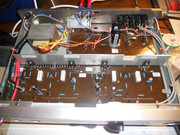To finish off this topic:-
I gutted a Marantz 30W/channel amp that had failed and built this circuit inside it:-

This is what the finished board looked like

The advantage of this circuit is that it uses darlington transistors so the driver transistor has a much easier life.
I don't know why the original circuit was prone to oscillation but this one does not suffer from that problem. The new Stones album Hackney Diamonds sounds fantastic on this with my big monitor speakers
https://groupdiy.com/threads/3-way-monitors-from-scratch.68941/
best
DaveP
I gutted a Marantz 30W/channel amp that had failed and built this circuit inside it:-

This is what the finished board looked like

The advantage of this circuit is that it uses darlington transistors so the driver transistor has a much easier life.
I don't know why the original circuit was prone to oscillation but this one does not suffer from that problem. The new Stones album Hackney Diamonds sounds fantastic on this with my big monitor speakers
https://groupdiy.com/threads/3-way-monitors-from-scratch.68941/
best
DaveP


